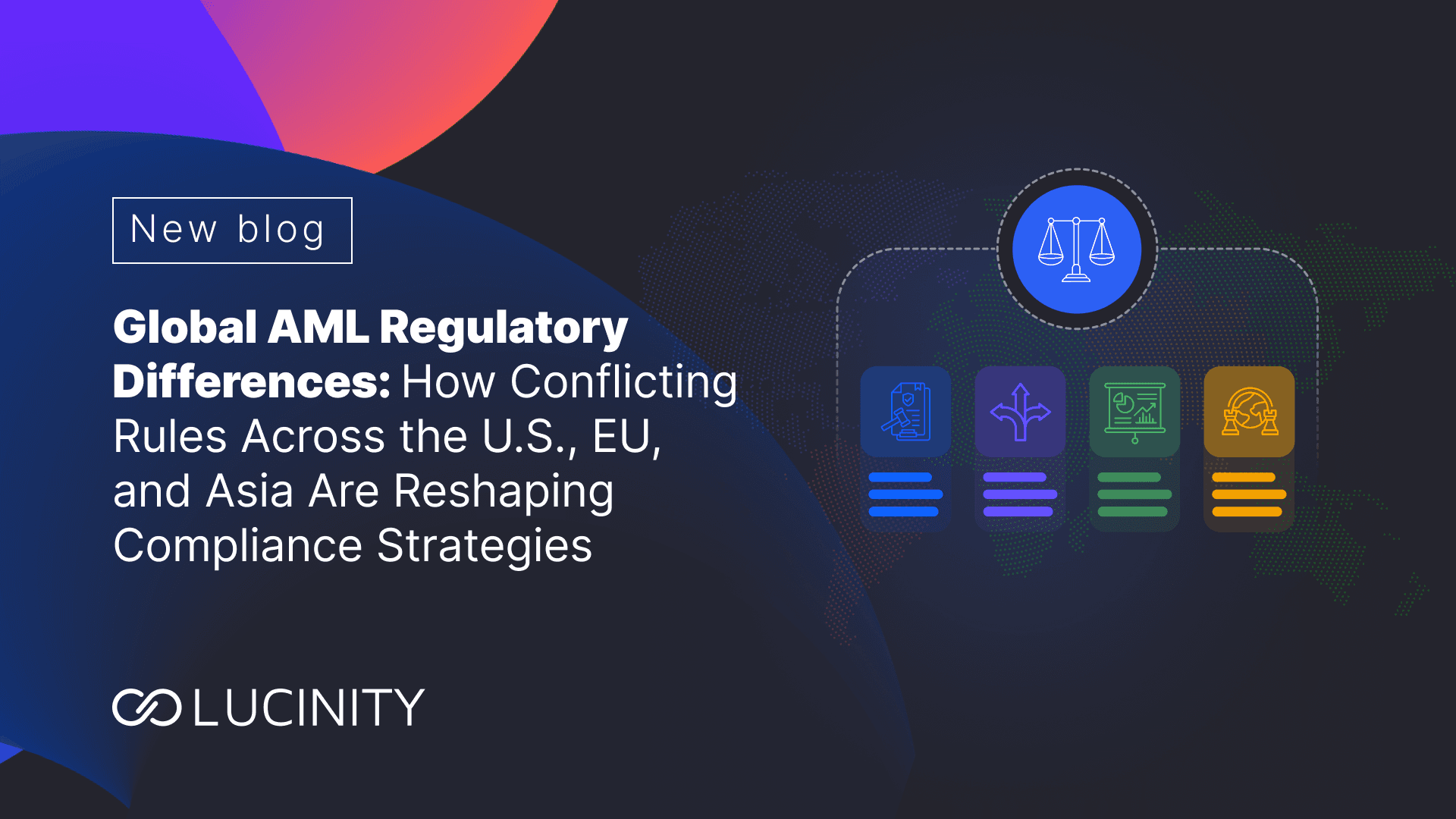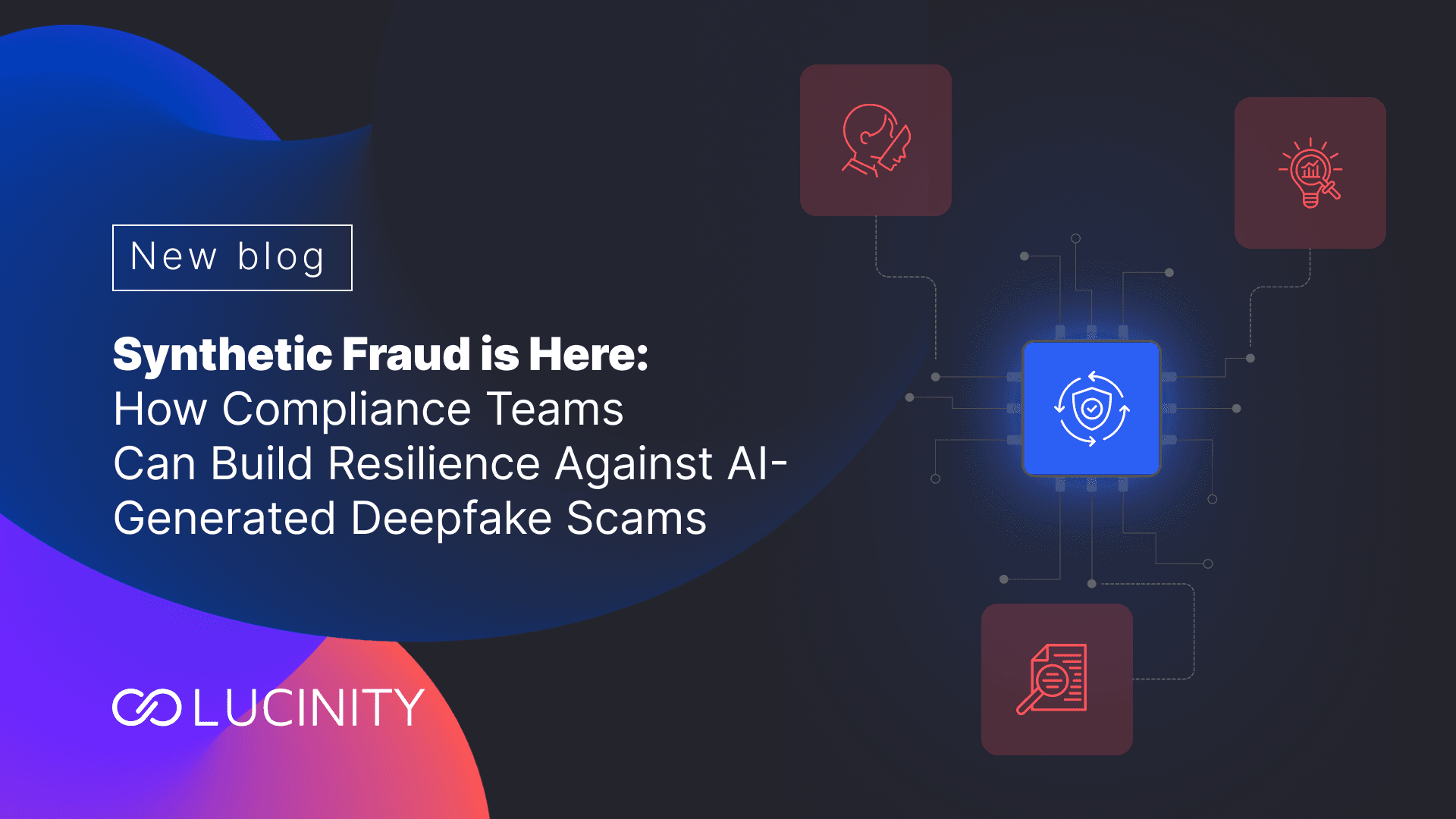AI and Compliance: Breaking Down Barriers to Smarter Financial Crime Prevention
Lucinity’s latest Actionable Intelligence webinar explores the transition from traditional compliance processes to AI-driven financial crime operations
Lucinity’s Actionable Intelligence webinar series recently featured a discussion on transforming financial crime compliance through AI. Moderated by Guðmundur Kristjánsson (GK), CEO of Lucinity, the session welcomed John McCarthy, a compliance executive with experience at Airbnb, Citi, and BMO.
Together, they explored the challenges compliance teams face in switching from manual processes to AI-driven operations and how financial institutions can manage regulatory concerns, secure executive buy-in, and guide their teams through the transition.
With AI becoming an essential tool in financial crime prevention, the discussion focused on its impact, how compliance teams can prepare for AI adoption, and what the future holds for financial institutions that adopt this transformation.
Key Insights from the Webinar
GK opened the discussion by addressing concerns about transitioning from traditional compliance methods to AI-driven systems. He compared outdated processes to a melting iceberg, emphasizing the need for change. The conversation focused on making AI adoption practical—securing regulatory confidence, executive buy-in, and team readiness.
John McCarthy, with experience across law enforcement, banking, and fintech, highlighted that compliance is constantly evolving as regulators raise expectations. He stressed that AI isn’t a replacement for human expertise but a tool to enhance efficiency, accuracy, and onboarding speed.
What are the biggest differences between compliance in traditional banks and tech-driven companies?
John McCarthy reflected on his experience across banking and fintech, particularly at Airbnb. He emphasized that compliance is not one-size-fits-all—risk tolerance varies significantly between traditional financial institutions and tech-forward companies. Banks operate with well-defined regulatory frameworks, while fintechs must balance compliance with business agility.
However, regardless of structure, all companies share the same goal, preventing FinCrime. The challenge lies in tailoring compliance programs to fit the unique risk appetite and operational model of each organization.
How has financial crime compliance evolved, and where is it heading?
While regulatory scrutiny has remained intense, expectations have increased. Compliance teams must now go beyond traditional check-the-box exercises to actively refine processes. John noted that the biggest change has been the growing reliance on technology.
Previously manual, compliance now leverages automation and AI-driven solutions to enhance detection and streamline investigations. Going forward it will move from a reactive to a proactive approach using AI to process large datasets in real time and improve decision-making.
What role does AI play in the future of financial crime compliance?
John stressed that AI is not a replacement for compliance professionals but a tool to enhance their effectiveness. He highlighted three primary areas where AI delivers the most impact:
- Accelerating onboarding – AI can reduce the time it takes for new analysts to become proficient, guiding them through complex investigations.
- Enhancing risk detection – AI-driven models can identify patterns and anomalies faster than traditional rule-based systems.
- Improving efficiency – Automating repetitive tasks frees up compliance teams to focus on higher-value investigations.
GK compared AI in compliance to Excel in finance—accountants still exist, but Excel made them efficient. Similarly, AI will not eliminate compliance teams but will enable them to work smarter and more effectively.
Why do compliance teams hesitate to transition to AI-driven systems?
Fear of change remains one of the biggest barriers. Compliance professionals are generally cautious, relying on established processes approved by regulators. John noted that many teams are reluctant to disrupt a system that, while inefficient, has historically worked.
However, he warned that sticking to outdated methods is also a risk. Regulators increasingly expect institutions to leverage advanced tools, and those that fail to modernize may face heightened scrutiny. The challenge is addressing resistance by showing that AI strengthens rather than replaces existing compliance processes.
How can compliance leaders secure executive buy-in for AI adoption?
Convincing leadership to invest in AI is often difficult due to concerns about ROI and regulatory acceptance. John recommended a strategic approach:
- Start small – Pilot AI in targeted areas, such as improving case summaries or automating transaction monitoring reviews.
- Demonstrate success – Use pilot results to show measurable improvements in efficiency, accuracy, and risk detection.
- Position AI as scalable – Executives are more likely to support AI when they see it as an adaptable solution that grows with business needs.
GK reinforced that gradual adoption is key. Rather than pitching AI as a disruptive overhaul, compliance teams should present it as an enhancement to existing workflows.
Where does AI provide the greatest impact on financial crime compliance?
AI delivers significant value in two key areas:
- Data synthesis – Compliance teams handle large volumes of alerts, reports, and external data. AI aggregates and analyzes this information, allowing analysts to focus on high-risk cases rather than sorting through false positives.
- Quality assurance (QA) – Traditional compliance QA processes rely on sample-based reviews, meaning only a small percentage of cases are checked. AI enables 100% real-time QA, ensuring consistency across all investigations and reducing errors before reports reach regulators.
John highlighted that AI enhances human decision-making rather than replacing it. AI eliminates repetitive tasks, enabling compliance professionals to focus on meaningful investigative work.
How will AI change compliance team structures?
A major concern with AI adoption is job displacement. John dismissed the idea that AI will replace compliance officers, explaining that it will instead refine their roles. AI-driven automation will push compliance teams from manual data processing to strategic oversight.
New skills will be required—leaders must learn how to manage AI-driven workflows, interpret AI-generated insights, and adapt investigative approaches accordingly. The result will be leaner and agile compliance teams focused on high-value work rather than administrative tasks.
How can compliance leaders drive AI adoption within their organizations?
For compliance professionals eager to implement AI, John suggested a structured approach:
- Understand existing workflows – Identify inefficiencies in current compliance operations.
- Start with small pilots – Test AI in controlled areas like transaction monitoring or SAR filings.
- Control the data – Prioritize use cases where compliance teams control data inputs directly.
- Build internal AI advocates – Identify early adopters within the team to drive enthusiasm and momentum.
- Engage regulators proactively – Demonstrate AI’s benefits through controlled pilots to build trust with regulators and auditors.
GK echoed the importance of gradual implementation, emphasizing that compliance teams don’t need to overhaul their entire system overnight. Starting with one or two high-impact areas allows them to build confidence and scale AI adoption effectively.
What excites compliance leaders most about AI’s potential?
John highlighted AI’s ability to synthesize data and improve investigative efficiency as its most valuable contribution. AI allows investigators to focus on high-risk cases by filtering out low-priority alerts.
Another transformative aspect is real-time quality assurance (QA). Traditionally, QA relies on sampling, meaning only a fraction of cases are reviewed. AI enables full-case coverage, ensuring accuracy across an institution’s compliance program.
John predicted that AI will advance compliance from reactive to proactive, allowing financial institutions to anticipate risks instead of responding after they occur.
What are the biggest lessons compliance professionals should take in the AI era?
As the conversation wrapped up, John shared three key takeaways:
- People drive compliance success – A strong culture of innovation and continuous improvement is essential for AI adoption.
- Start small and iterate – Large-scale AI adoption isn’t necessary. Incremental improvements yield long-term success.
- Understand risk tolerance – AI adoption should align with an institution’s broader compliance strategy and risk appetite.
GK reinforced that AI adoption starts with a single step. The teams that embrace small, strategic changes today will be best positioned to lead compliance innovation in the future.
Wrapping Up
GK closed by reinforcing AI’s role as a necessity, not a threat. Regulators expect innovation and teams that resist risk falling behind. He encouraged starting small identifying quick wins to build confidence and drive adoption.
McCarthy agreed, emphasizing a culture of continuous improvement. He advised compliance officers to understand their current operations, test AI in controlled settings, and use early successes to gain executive support. GK wrapped up by urging teams to take the first step—change doesn’t require a revolution, just action.
Lucinity’s Approach: AI as a Force Multiplier for Compliance Teams
The webinar highlighted a key reality—AI is not here to replace compliance professionals but to assist them. Lucinity follows this principle by offering AI-driven compliance solutions that improve investigative accuracy, streamline operations, and help financial institutions expand compliance efforts without compromising oversight.
Connecting Automation with Human Expertise
Lucinity’s platform integrates human-AI collaboration, enabling compliance teams to leverage automation while maintaining full control in decision-making. AI manages repetitive tasks like data collection, case summarization, and quality assurance, freeing investigators to concentrate on risk assessment, strategic oversight, and regulatory engagement.
Key Features of Lucinity’s AI-Powered Compliance Platform
- Behavioral Insights Engine – Lucinity’s AI extends beyond transaction monitoring by analyzing behavioral patterns, allowing compliance teams to detect financial crime more accurately while reducing false positives.
- SAR Automation – AI simplifies suspicious activity report (SAR) creation by automating data collation, drafting templates, and formatting reports, reducing the burden on investigators.
- Case Management System (CMS) – Investigators can assign, collaborate, and track case progress within a single, intuitive platform that consolidates alerts and flagged activities.
- Real-Time Quality Assurance (QA) – Unlike traditional sample-based QA reviews, Lucinity enables 100% case review in real-time, improving accuracy and regulatory confidence.
- Automated Case Summarization with Luci – Lucinity’s AI-powered copilot, extracts key insights from case data, minimizing manual work and helping investigators focus on high-priority cases.
- Dynamic Risk Scoring – Lucinity assesses risk in real-time, updating scores based on behavioral patterns and transaction history to highlight high-risk activities.
- Seamless System Integration – Unlike rigid legacy systems, Lucinity’s API-first architecture enables compliance teams to integrate AI without disrupting existing workflows.
- Explainable AI & Transparent Audits – Each AI-driven recommendation includes a clear audit trail, ensuring regulatory compliance and investigator confidence.
The insights from the webinar align with Lucinity’s vision: AI should amplify human expertise, not replace it. Lucinity automates repetitive processes and delivers clear, actionable insights, helping compliance teams work efficiently lower operational costs, and improve financial crime detection.
Regulatory demands are evolving but AI-driven solutions like Lucinity help financial institutions adapt, improve workflows, and strengthen financial crime detection.
Meet the Speakers
John McCarthy
John McCarthy is a compliance executive with experience spanning law enforcement, national security, and financial services. He has held leadership roles at major banks and fintechs, including Citi, BMO, and Airbnb, where he served as the first Payments Chief Compliance Officer. His expertise bridges traditional banking compliance with innovative, tech-driven risk management approaches.
Guðmundur Kristjánsson (GK)
As the Founder and CEO of Lucinity, GK has dedicated his career to improving financial crime compliance through AI and human expertise. With experience at Citigroup and NICE Systems, he has been instrumental in AI-driven compliance advancements, helping financial institutions improve detection accuracy and operational efficiency.
Conclusion: The Compliance Iceberg Is Melting—Are You Ready?
The webinar underscored an important message: AI is not a threat to compliance but a necessary tool for adapting to the changing financial crime environment. Compliance teams that adopt AI will improve efficiency, enhance risk detection, and stay aligned with regulations, while those who resist may lag.
As GK emphasized, AI will not replace compliance officers, but compliance officers who use AI will replace those who don’t.
For a better exploration of how AI is transforming financial crime compliance, watch the full webinar recording- https://youtu.be/ai1vQcxsfbk





